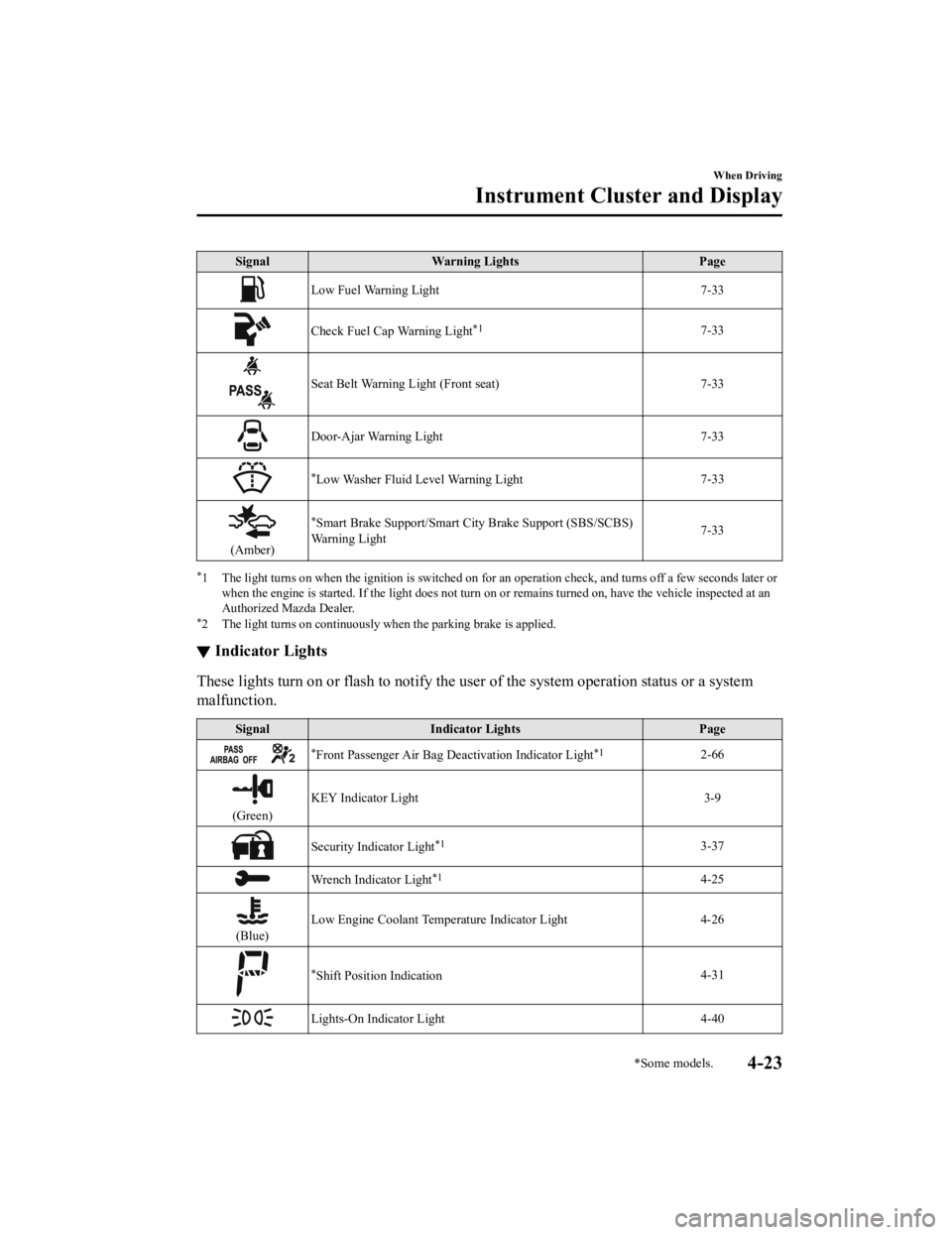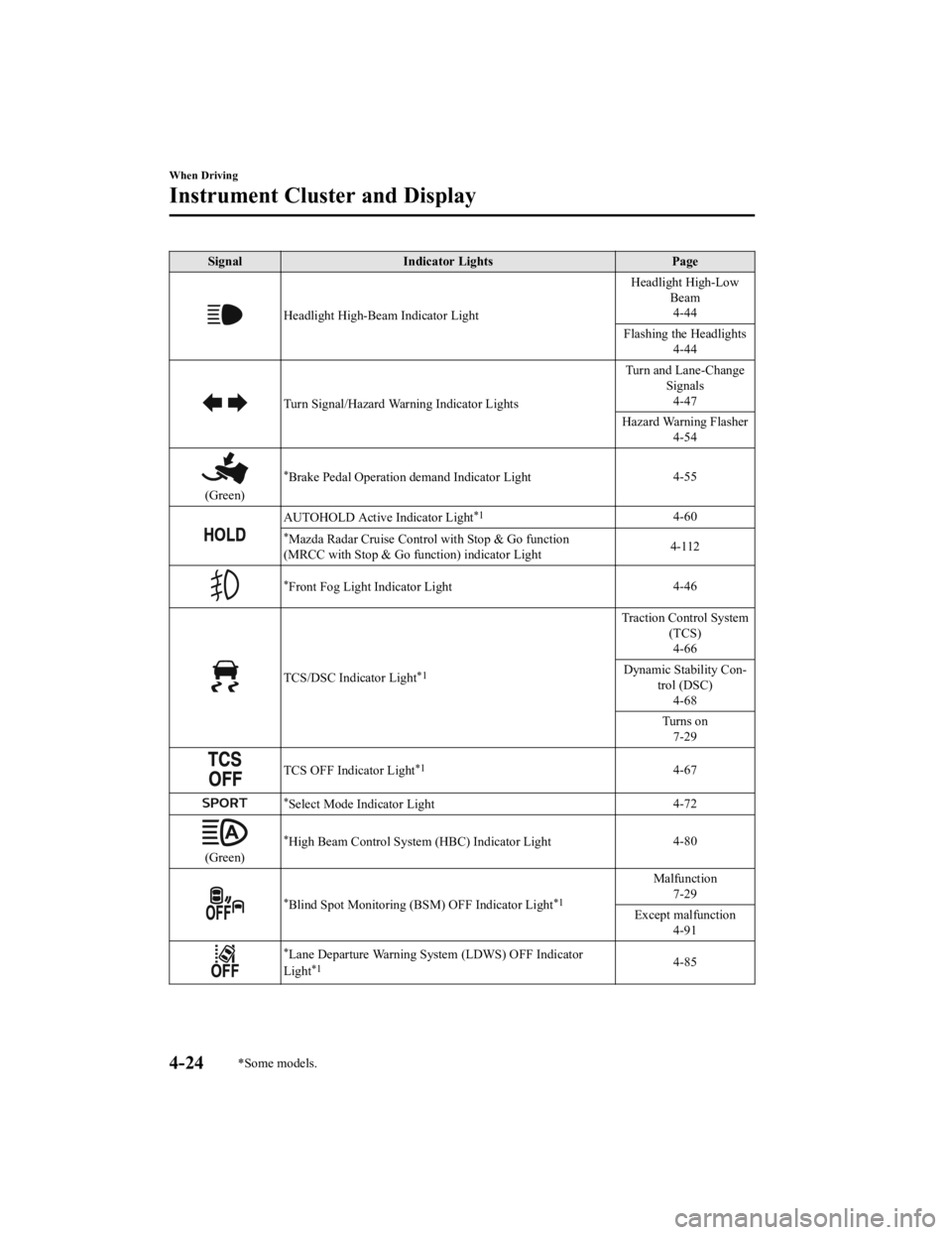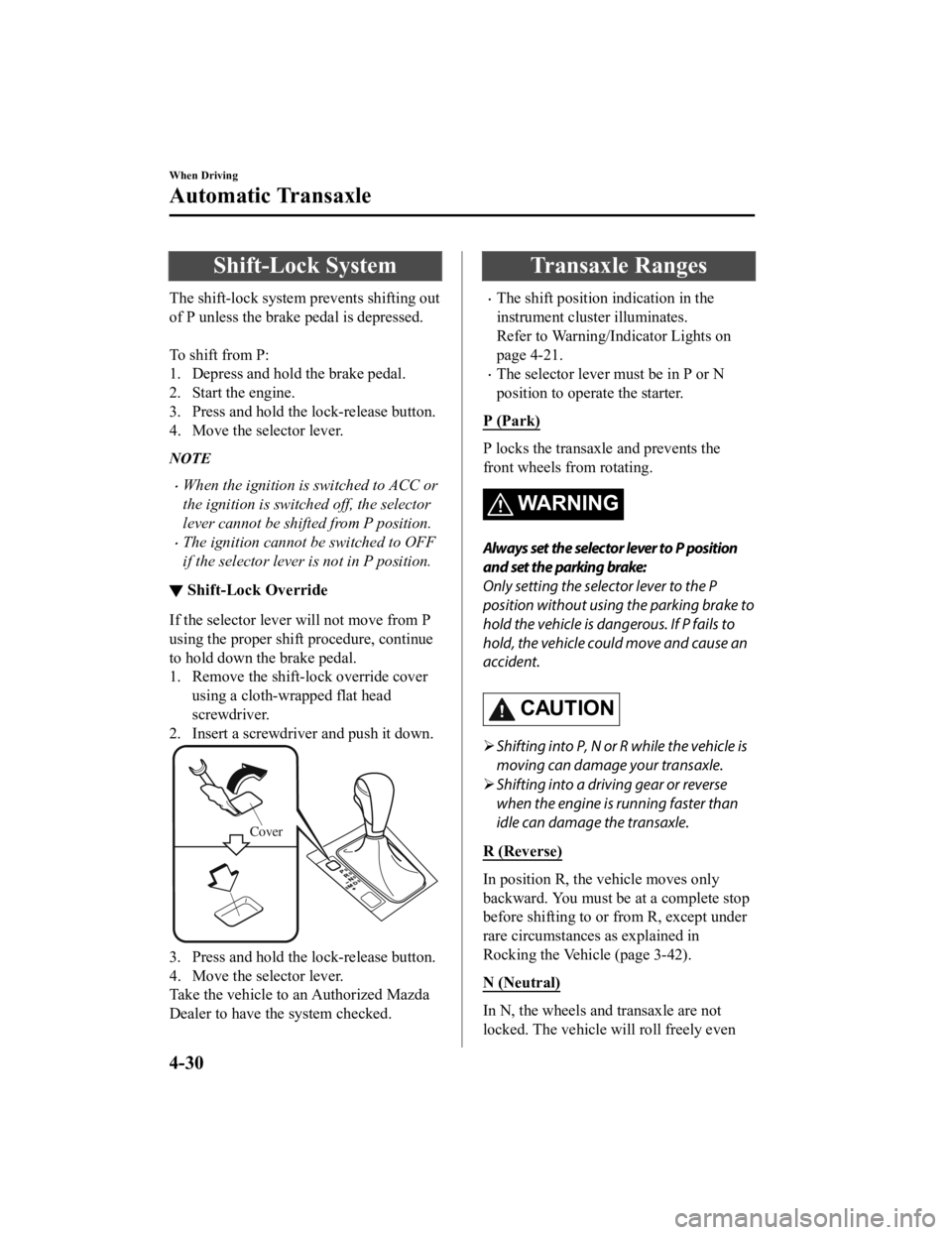warning light MAZDA MODEL CX-3 2021 Owner's Guide
[x] Cancel search | Manufacturer: MAZDA, Model Year: 2021, Model line: MODEL CX-3, Model: MAZDA MODEL CX-3 2021Pages: 618, PDF Size: 64.58 MB
Page 149 of 618

’éĘThe display may be difficult to view or temporarily affected by weather conditions such as
rain, snow, light, and temperature.
’éĘIf the audio system is removed, the active driving display cannot be operated.
The active driving display indi cates the following information:
’éĘBlind Spot Monitoring (BSM) Op eration Conditions and Warnings
Refer to Blind Spot Monitoring (BSM) on page 4-87.
’éĘDistance Recognition Support System (DRSS) Warnings
Refer to Distance Recognition Support System (DRSS) on page 4-99.
’éĘTraffic Sign Recognition System (TSR) traffic signs and Warnings
Refer to Traffic Sign Recognition System (TSR) on page 4-93.
’éĘMazda Radar Cruise Control wi th Stop & Go function (MRCC with Stop & Go function)
Operation Conditions and Warnings
Refer to Mazda Radar Cruise Control with Stop & Go function (MRCC with Stop & Go
function) on page 4-104.
’éĘLane Departure Warning System (LDWS) Operation Conditions and Warnings
Refer to Lane Departure Warning System (LDWS) on page 4-82.
’éĘAdvanced Smart City Brake Support (Advanced SCBS) Warnings
Refer to Advanced Smart City Brake Support (Advanced SCBS) on page 4-116.
’éĘSmart City Brake Support (SCBS) Warnings
Refer to Smart City Brake Support (SCBS) on page 4-120.
’éĘSmart Brake Support (SBS) Warnings
Refer to Smart Brake Support (SBS) on page 4-123.
’éĘCruise Control Operation Conditions
Refer to Cruise Control on page 4-136.
’éĘNavigation Guidance (vehicles with navigation system)
’éĘSpeed limit indicator (vehicles with navigation system)
’éĘVehicle Speed
Each setting/adjustment for the active driving display can be performed on the center
display.
1. Select the
icon on the home screen and display the Settings screen.
2. Select the AD-Disp tab.
3. Select the desired item and perform the setting/adjustment.
’éĘMethod for adjusting screen br ightness (automatically/manually)
’éĘScreen brightness initial settings (automatic adjustment is selected)
’éĘScreen brightness adjustment (manual adjustment is selected)
When Driving
Instrument Cluster and Display
4-19
CX-3_8JL1-EA-20G_Edition1_old 2020-5-22 15:31:00
Page 151 of 618

Warning/Indicator Lights
Instrument Cluster varies depending on model and specifications.
Warning/Indicator lights will appear in any of the highlighted areas
Type A
Type B
Center of Dashboard (Digital Speed Meter Type)
(Analog Speed Meter Type)
Instrument Cluster
Ō¢╝
Warning Lights
These lights turn on or flash to notify the us
er of the system operation status or a system
malfunction.
Signal Warning Lights Page
Brake System Warning Light*1*27-26
ABS Warning Light*1
Electronic Brake Force
Distribution System Wa r n i n g7-26
ABS warning 7-29
Charging System Warning Light*17-26
When Driving
Instrument Cluster and Display
4-21
CX-3_8JL1-EA-20G_Edition1_old 2020-5-22 15:31:00
Page 152 of 618

SignalWarning Lights Page
Engine Oil Warning Light*17-26
(Red)High Engine Coolant Temperature Warning Light
*17-26
Power Steering Malfunction Indicator Light*17-26
Master Warning Light*17-29
Electric Parking Brake (EPB) Warning Light*17-29
(Red)Brake Pedal Operation Demand Warning Light
*1
Flashing
4-59
Buzzer & Flashing 7-29
Check Engine Light*17-29
*Automatic Transaxle Warning Light*17-29
Air Bag/Front Seat Belt Preten sioner System Warning Light*17-29
*AWD Warning Light*17-29
*Tire Pressure Monitoring System Warning Light*1
Flashing
7-29
Turns on 7-33
(Red) KEY Warning Light
*1
Turns on
7-29
Flashing 7-33
(Amber)
*High Beam Control System (HBC) Warning Light*17-29
*Lane Departure Warning System (LDWS) Warning Light*1
Flashing4-85
Turns on 7-29
(Amber)
*Mazda Radar Cruise Control with Stop & Go function
(MRCC with Stop & Go function) Warning Indication 7-29
*LED Headlight Warning Light*17-29
When Driving
Instrument Cluster and Display
4-22*Some models.
CX-3_8JL1-EA-20G_Edition1_old
2020-5-22 15:31:00
Page 153 of 618

SignalWarning Lights Page
Low Fuel Warning Light 7-33
Check Fuel Cap Warning Light*17-33
Seat Belt Warning Light (Front seat) 7-33
Door-Ajar Warning Light7-33
*Low Washer Fluid Level Warning Light7-33
(Amber)
*Smart Brake Support/Smart C
ity Brake Support (SBS/SCBS)
Wa r n i n g L i g h t 7-33
*1 The light turns on when the ignition is switched on for an operation check, and turns off a few seconds later or
when the engine is started. If the light does not turn on or remains turned on, have the vehicle inspected at an
Authorized Mazda Dealer.
*2 The light turns on continuously when the parking brake is applied.
Ō¢╝ Indicator Lights
These lights turn on or flash to notify the us
er of the system operation status or a system
malfunction.
Signal Indicator Lights Page
*Front Passenger Air Bag Deactivation Indicator Light*12-66
(Green)KEY Indicator Light 3-9
Security Indicator Light*13-37
Wrench Indicator Light*14-25
(Blue)
Low Engine Coolant Temperature Indicator Light 4-26
*Shift Position Indication
4-31
Lights-On Indicator Light
4-40
When Driving
Instrument Cluster and Display
*Some models.4-23
CX-3_8JL1-EA-20G_Edition1_old 2020-5-22 15:31:00
Page 154 of 618

SignalIndicator Lights Page
Headlight High-Beam Indicator Light Headlight High-Low
Beam4-44
Flashing the Headlights 4-44
Turn Signal/Hazard Warning Indicator Lights Turn and Lane-Change
Signals4-47
Hazard Warning Flasher 4-54
(Green)
*Brake Pedal Operation demand Indicator Light 4-55
AUTOHOLD Active Indicator Light*14-60
*Mazda Radar Cruise Control with Stop & Go function
(MRCC with Stop & Go function) indicator Light 4-112
*Front Fog Light Indicator Light
4-46
TCS/DSC Indicator Light*1
Traction Control System
(TCS)4-66
Dynamic Stability Con ŌĆÉ
trol (DSC) 4-68
Turns on 7-29
TCS OFF Indicator Light*14-67
*Select Mode Indicator Light 4-72
(Green)
*High Beam Control System (HBC) Indicator Light4-80
*Blind Spot Monitoring (BSM) OFF Indicator Light*1
Malfunction
7-29
Except malfunction 4-91
*Lane Departure Warning System (LDWS) OFF Indicator
Light*14-85
When Driving
Instrument Cluster and Display
4-24*Some models.
CX-3_8JL1-EA-20G_Edition1_old 2020-5-22 15:31:00
Page 160 of 618

Shift-Lock System
The shift-lock system prevents shifting out
of P unless the brake pedal is depressed.
To shift from P:
1. Depress and hold the brake pedal.
2. Start the engine.
3. Press and hold the lock-release button.
4. Move the selector lever.
NOTE
’éĘWhen the ignition is switched to ACC or
the ignition is switched off, the selector
lever cannot be shifted from P position.
’éĘThe ignition cannot be switched to OFF
if the selector lever is not in P position.
Ō¢╝ Shift-Lock Override
If the selector lever will not move from P
using the proper shift procedure, continue
to hold down the brake pedal.
1. Remove the shift-lock override cover
using a cloth-wr apped flat head
screwdriver.
2. Insert a screwdriver and push it down.
Cover
3. Press and hold the lock-release button.
4. Move the selector lever.
Take the vehicle to an Authorized Mazda
Dealer to have the system checked.
Transaxle Ranges
’éĘThe shift position indication in the
instrument cluster illuminates.
Refer to Warning/Indicator Lights on
page 4-21.
’éĘThe selector lever must be in P or N
position to operate the starter.
P (Park)
P locks the transaxle and prevents the
front wheels from rotating.
WA R N I N G
Always set the selector lever to P position
and set the parking brake:
Only setting the selector lever to the P
position without using the parking brake to
hold the vehicle is dangerous. If P fails to
hold, the vehicle could move and cause an
accident.
CAUTION
’āś Shifting into P, N or R while the vehicle is
moving can damage your transaxle.
’āś Shifting into a driving gear or reverse
when the engine is running faster than
idle can damage the transaxle.
R (Reverse)
In position R, the vehicle moves only
backward. You must be at a complete stop
before shifting to or from R, except under
rare circumstances as explained in
Rocking the Vehicle (page 3-42).
N (Neutral)
In N, the wheels and transaxle are not
locked. The vehicle will roll freely even
When Driving
Automatic Transaxle
4-30
CX-3_8JL1-EA-20G_Edition1_old 2020-5-22 15:31:00
Page 161 of 618

on the slightest incline unless the parking
brake or brakes are on.
WARNING
If the engine is running faster than idle, do
not shift from N or P into a driving gear:
It's dangerous to shift from N or P into a
driving gear when the engine is running
faster than idle. If this is done, the vehicle
could move suddenly, causing an accident
or serious injury.
Do not shift into N when driving the
vehicle:
Shifting into N while driving is dangerous.
Engine braking cannot be applied when
decelerating which could lead to an
accident or serious injury.
CAUTION
Do not shift into N when driving the
vehicle. Doing so can cause transaxle
damage.
NOTE
Apply the parking brake or depress the
brake pedal before moving the selector
lever from N position to prevent the
vehicle from moving unexpectedly.
D (Drive)
D is the normal driving position. From a
stop, the transaxle wi ll automatically shift
through a 6-gear sequence.
M (Manual)
M is the manual shift mode position.
Gears can be shifted up or down by
operating the selector lever. Refer to
Manual Shift Mode on page 4-32.
Ō¢╝ Shift Position Indication
The selector position is indicated when the
ignition is switched ON.
Gear position indication
In manual shift mode, the ŌĆ£MŌĆØ of the shift
position indication illuminates and the
numeral for the selected gear is displayed.
Ō¢╝Active Adaptive Shift (AAS)
Active Adaptive
Shift (AAS)
automatically controls the transaxle shift
points to best suit the road conditions and
driver input. This improves driving feel.
The transaxle may switch to AAS mode
when driving up and down slopes,
cornering, driving at high elevations, or
depressing the accelerator pedal quickly
while the selector lever is in the D
position. Depending on the road and
driving conditions/ve hicle operations, gear
shifting could be delayed or not occur,
however, this does not indicate a problem
because the AAS mode will maintain the
optimum gear position.
When Driving
Automatic Transaxle
4-31
CX-3_8JL1-EA-20G_Edition1_old 2020-5-22 15:31:00
Page 169 of 618

Driving Tips
WARNING
Do not let the vehicle move in a direction
opposite to the direction selected by the
selector lever:
Do not let the vehicle move backward with
the selector lever in a forward position, or
do not let the vehicle move forward with
the selector lever in the reverse position.
Otherwise, the engine may stop, causing
the loss of the power brake and power
steering functions, and make it difficult to
control the vehicle which could result in an
accident.
Passing
For extra power when passing another
vehicle or climbing steep grades, depress
the accelerator fully. The transaxle will
shift to a lower gear, depending on vehicle
speed.
NOTE
’éĘ(Some models)
The accelerator pedal may initially feel
heavy as it is being depressed, then feel
lighter as it is depressed further. This
change in pedal force aids the engine
control system in determining how much
the accelerator pedal has been
depressed for performing kickdown, and
functions to control whether or not
kickdown should be performed.
’éĘWhile the selector lever is in the M
position and the TCS is turned off,
manual shift mode does not switch to
automatic shift mode even if the
accelerator pedal is completely
depressed. Operate the selector lever.
Climbing steep grades from a stop
To climb a steep grade from a stopped
position:
1. Depress the brake pedal.
2. Shift to D or M1, depending on the load weight and grade steepness.
3. Release the brake pedal while gradually accelerating.
Descending steep grades
When descending a steep grade, shift to
lower gears, depending on load weight and
grade steepness. Descend slowly, using the
brakes only occasionally to prevent them
from overheating.
When Driving
Automatic Transaxle
4-39
CX-3_8JL1-EA-20G_Edition1_old 2020-5-22 15:31:00
Page 184 of 618

Hazard Warning Flasher
The hazard warning lights should always
be used when you stop on or near a
roadway in an emergency.
The hazard warning lights warn other
drivers that your vehicle is a traffic hazard
and that they must take extreme caution
when near it.
Depress the hazard warning flasher and all
the turn signals will flash. The hazard
warning indicator ligh ts in the instrument
cluster flash simultaneously.
NOTE
’éĘThe turn signals do not work when the
hazard warning lights are on.
’éĘCheck local regulations about the use of
hazard warning lights while the vehicle
is being towed to verify that it is not in
violation of the law.
When Driving
Switches and Controls
4-54
CX-3_8JL1-EA-20G_Edition1_old 2020-5-22 15:31:00
Page 185 of 618

Brake System
Ō¢╝Foot Brake
This vehicle has power-assisted brakes
that adjust automatically through normal
use.
Should power-assist fail, you can stop by
applying greater force than normal to the
brake pedal. But the distance required to
stop will be greater than usual.
WARNING
Do not coast with the engine stalled or
turned
off,
find a safe place to stop:
Coasting with the engi ne stalled or turned
off is dangerous. Braking will require more
effort, and the brake's power-assist could
be depleted if you pump the brake. This will
cause longer stopping distances or even an
accident.
Shift to a lower gear when going down
steep hills:
Driving with your foot continuously on the
brake pedal or steadily applying the brakes
for long distances is dangerous. This causes
overheated brakes, resulting in longer
stopping distances or even total brake
failure. This could cause loss of vehicle
control and a serious accident. Avoid
continuous application of the brakes.
Dry off brakes that have become wet by
driving slowly, releasing the accelerator
pedal and lightly applying the brakes
several times until the brake performance
returns to normal:
Driving with wet brakes is dangerous.
Increased stopping distance or the vehicle
pulling to one side when braking could
result in a serious accident. Light braking
will indicate whether the brakes have been
affected.
CAUTION
’āś Do not drive with your foot held on the
brake pedal. Doing so could result in the
following:
’āś The brake parts will wear out more
quickly.
’āś The brakes can overheat and adversely
affect brake performance.
’āś Always depress the brake pedal with the
right foot. Applying the brakes with the
unaccustomed left foot could slow your
reaction time to an emergency situation
resulting in insufficient braking
operation.
’āśWear shoes appropriate for driving in
order to avoid your shoe contacting the
brake pedal when depressing the
accelerator pedal.
Ō¢╝ Electric Parking Brake (EPB)
The EPB equipment applies the parking
brake using an electric motor. When the
When Driving
Brake
4-55
CX-3_8JL1-EA-20G_Edition1_old
2020-5-22 15:31:00